The Miracles of Fall
By Bob Rifchin
After nights on the beach visiting with nocturnal striped bass, it’s time to take advantage of the first late season opportunities in August with the arrival of “Funny Fish”– – bonito and false albacore. My kayak has spent the darkest hours perched on the back of my truck awaiting its trip to a new beach. Armed with my favorite 8 weight, I paddle into the waning darkness to the spot where I expect to find the fish at false dawn.
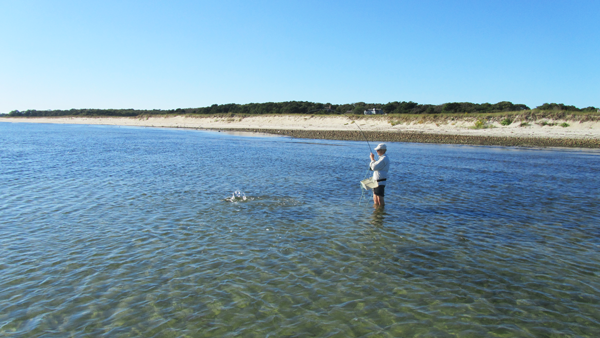 Those who chase the speedsters of late summer are usually up well before first light to find “Bones” and “Fat Alberts” slashing through hapless schools of baitfish (bay
Those who chase the speedsters of late summer are usually up well before first light to find “Bones” and “Fat Alberts” slashing through hapless schools of baitfish (bay
anchovies, peanut bunker, and silversides). On Cape Cod, this happens along the south-side beaches from Falmouth to Centerville where anglers are perched on jetties or head to sea in kayaks and small boats. Any opportunity to cast to these fish is brief as they reveal their location for only a few seconds before disappearing again into the depths. All the while anglers hope their fly is the right imitation for these picky creatures and that they have chosen a spot where the fish will appear. Those who have not chosen well relocate and try not to spook them. Run-and- gun attempts to get close to breaking fish are seldom profitable.
Both bonito and false albacore are like a drug and they draw people from their beds day after day because the strikes are vicious and always a surprise. This morning’s fish runs a hundred yards with the reel screaming in protest. The fish suddenly turns toward me so that I’m forced to tuck the rod under my arm and strip line with both hands to control the slack. Then, it goes deep and slugs it out, circling the kayak. Being in the right place at the right time takes experience and luck. For a day like this, having friends at different beaches with cell phones is a plus. You have to find the fish and everyone profits from shared information!
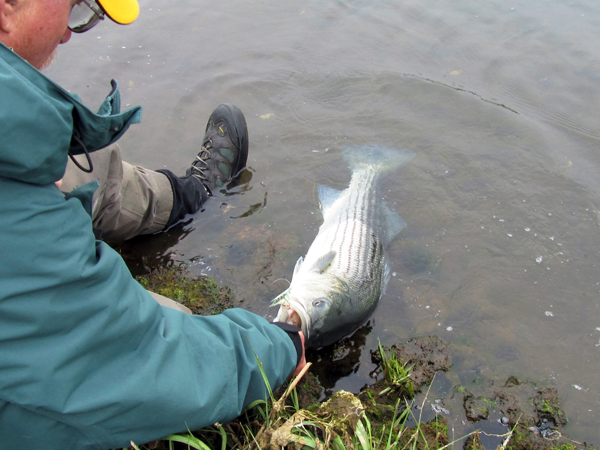
In two or three weeks, mornings spent fishing for false albacore finally slow, as the little tuna (really more closely related to the mackerel) become less abundant. They
linger well into October but I finally opt for a few hours of sleep before work. However, shorter days and the lower angle of the September sun have made changes. Large numbers of baitfish have moved close to shore followed by hungry stripers and bluefish.
Peanut bunker, silversides and mackerel join the sand eels that have spent the summer near shore. Night is still the best for bass, but more daytime activity is beginning as well. The fish have travel on their minds and they are looking for lots of food. The big bass often shadow the mackerel, particularly close to shore where there is other bait as well. I stayed all night at a favorite beach in hope of being in the right place as migrating stripers followed their yearly routes south. You don’t know if these location choices are right since the bass are here today and gone in an instant.
On this night, there was only one small bluefish. Day was approaching when suddenly I heard something to my right. Baitfish held tight against the rocky breakwater as I moved into position in the half-light of a foggy Cape Cod dawn. As most were peanut bunker, I chose a realistic imitation crafted to represent the same shape and coloration as the natural baitfish. I drifted the fly along the craggy underwater stones where they joined the sandy beach allowing the long-shore current to sweep my fly along the rocks. With each cast through the shower of frightened bait I expected a strike and was not disappointed when a fish ate the fly and ran seaward. It was a powerful fish and I expected to see at least a thirty-inch striper as I guided it to quiet water. The fish was only twenty inches, but was energized by the cooler water of early fall. After two runs and a bit of dogged resistance, I was looking for the next one.
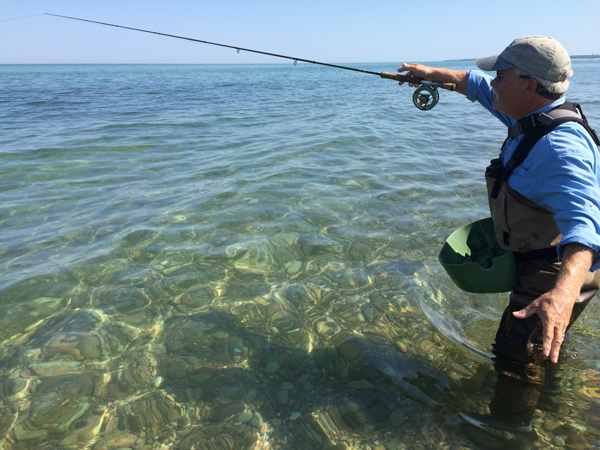
In the quiet of a pre-dawn early morning as the tide nears its peak, the unique silence of the salt pond is broken only by the rain-like sounds of thousands of fleeing
baitfish. They move across the surface in waves to escape the huge mouths of striped bass that follow them through the clear shallows, creating a maze of explosive washtub-sized swirls as evidence of their presence. It’s the end of a night’s action that seldom ever is visible in the light of day except during the fall migration. The salt ponds and small inland bays along the south side of the Cape are special places unknown to most anglers where stripers congregate to feed in shallow water. At night, fish are often at your feet or all around you and often continue well into the day.
It was an overcast dawn on the flood tide, the air heavy with the threat of rain as I slid the kayak into the water. The small opening to the sea from which both water and stripers came was nearly still and the surface disturbances in the shallows told me the fish were feeding. I was very late for the night fishing I’d planned but it looked like luck was with me. My first cast placed my silverside fly in the submerged grass at the edge of the first small indentation along the bank. My jerky retrieve was met by the visible wake of a charging striper moving through the subterranean forest. The grass parted next to the fly; there was no pause when the fish felt steel and bolted toward the middle of the open pond wildly trying to escape to deeper and safer waters. For two hours, fish after fish took the fly. Then my luck faded. With the dropping tide I was sure the bait flushing out of the pond drew the bass to the flats below so I followed. There in broad daylight I saw a blitz
in the shallows and without thinking I cast into the fray. The strike was hard and immediate; a scant moment later the line went slack. The clean cut at the end of the
leader told the story and I scrambled to add wire in front of the replacement silverside fly. These were the supreme opportunists of the Cape’s waters – bluefish or “Yellow-Eyed-Devils” – as some prefer to call them. The action was fast and furious for about half-an-hour, then they were gone as quickly as they appeared, looking for more baitfish. Finding blues is like locating stripers, though they can often be found in more humane daylight hours.
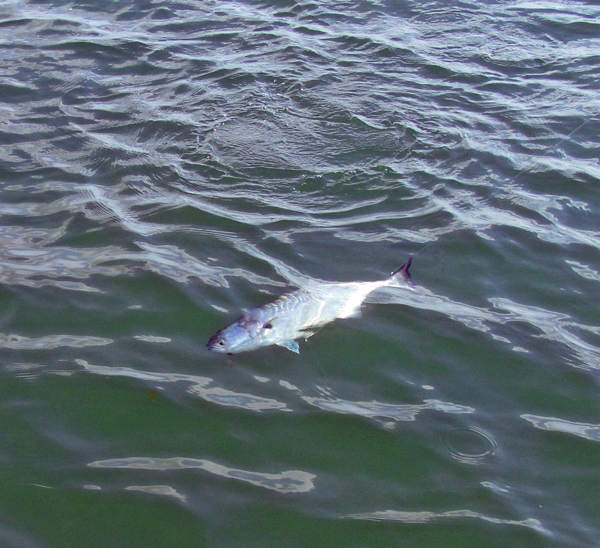 Work has a habit of intervening in more important “stuff” like fishing and it took a week before I got a late afternoon opportunity to get on the water again. I started at
Work has a habit of intervening in more important “stuff” like fishing and it took a week before I got a late afternoon opportunity to get on the water again. I started at
the Cape Cod Canal with my binoculars looking for birds or surface activity, then cruised from spot-to- spot along the north side of the peninsula. In the fall my rods are always in my truck. Any time that I am near the water is an opportunity to look for fish as they become more elusive with the passing days.
It was late morning when I first saw the creek on an extended trip to the hardware store. It was a pretty sight in the light, open and flat with green grasses surrounding a moving bluish ribbon of water. The air was full of birds moving off to feed, and little Sandpipers worked the beach just upstream. Gulls wheeled through the air crying out as they dove for baitfish. The mouth of the waterway where I stood was guarded on one side by a substantial breakwater and a sharply sloping rocky beach on my side of the inlet.
There were bigger swirls amongst the baitfish and another late season prayer wasanswered. I slipped into the water and began casting my sand-eel imitation. The sinking line took the fly deep as it swung past me and I began a slow twitching retrieve. Two strips later and a solid strike told me this was indeed a good place.
There are all sorts of possibilities when fishing the cusp of the sea and one can never be sure what will come next. I knew upon my return home, that I could find a way to explain the wet legs on my pants, though the connection with the small box of screws from that hardware store still on my front seat hadn’t yet come to me!

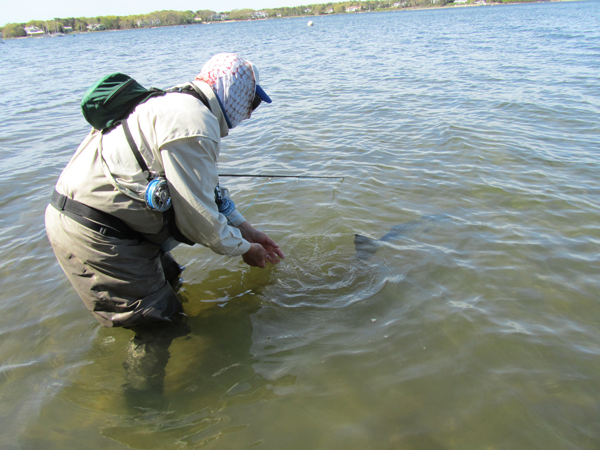
 SUBSCRIBE TO TAIL FLY FISHING MAGAZINE
SUBSCRIBE TO TAIL FLY FISHING MAGAZINE